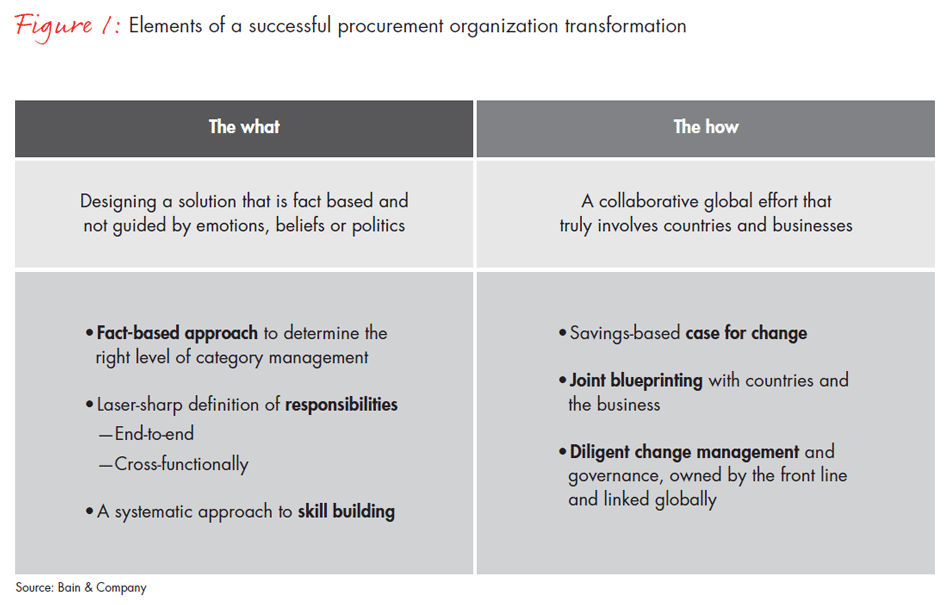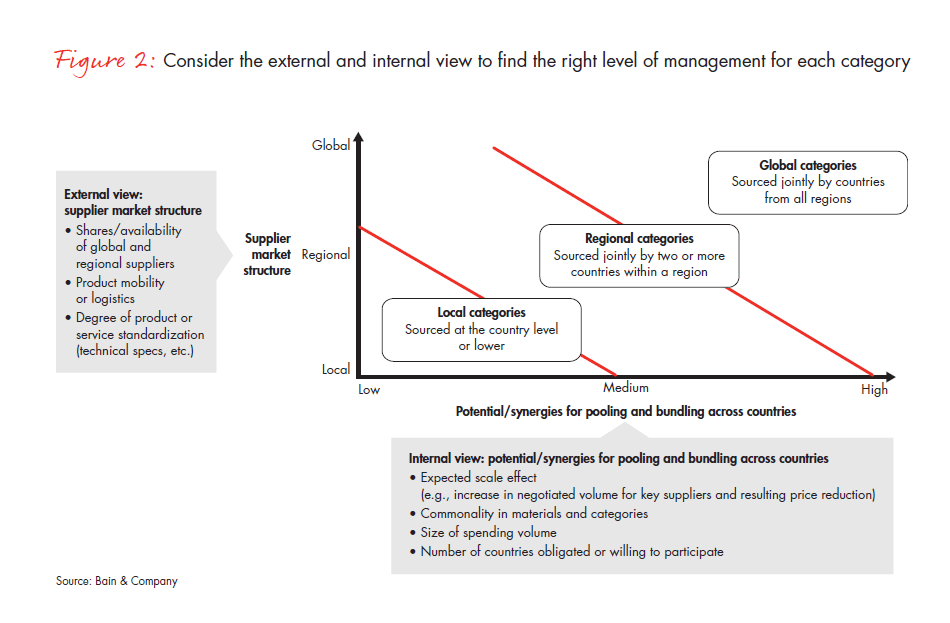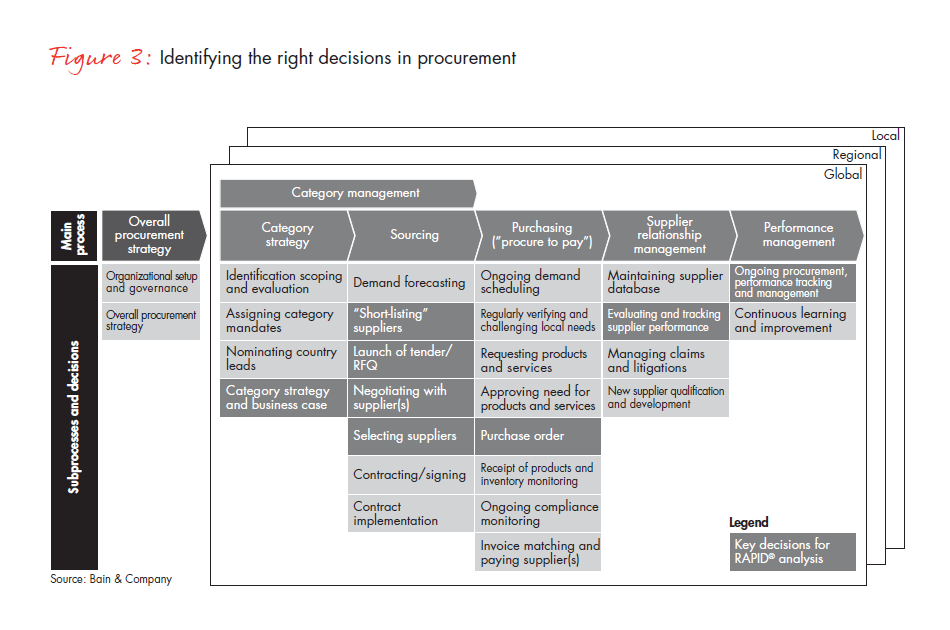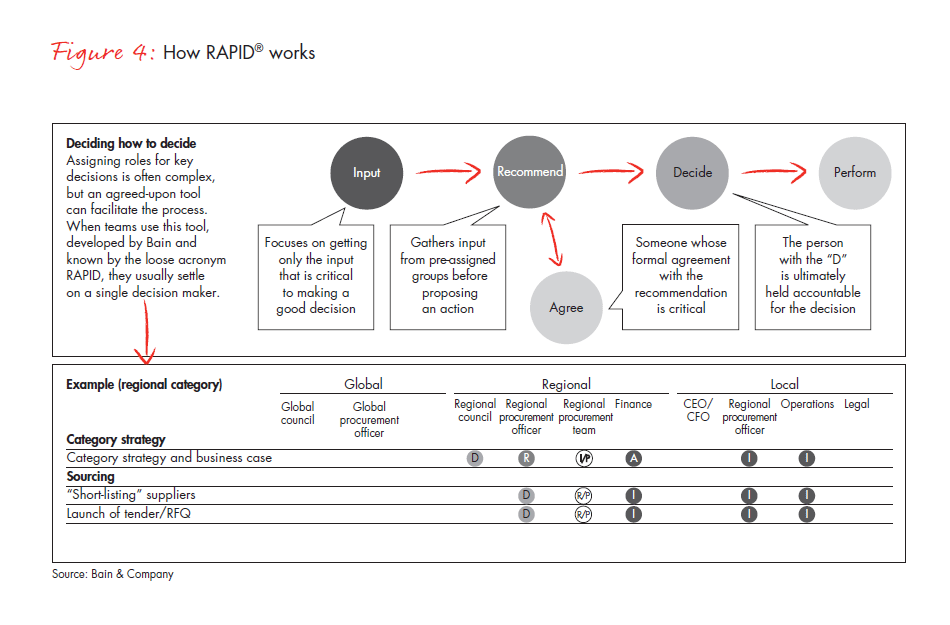Brief
The $20 billion industrial company was big and far-reaching—a global market leader with a presence in more than 60 countries and aggressive financial targets. To reach those targets, top management turned to procurement to generate savings. But when executives took stock of the existing procurement organization and capabilities, the massive challenge they faced came into sharp and discouraging focus.
What was wrong? The procurement organization struggled with factors that were largely out of its control. The company’s nearly 700 procurement employees functioned in strong but separate kingdoms across countries. They worked toward different objectives and had a poor track record for succeeding in global projects. Among the many issues: The global procurement function had less power than it needed, operated without a clear mandate and struggled to convince countries to participate in a coordinated global effort. The rare times when people did work together, the collaboration was ineffective. Coming to terms with this misalignment, missing skills and inadequate capabilities meant one thing: Global procurement was likely to disappoint.
While this scene may be the extreme, elements of it will be familiar to executives and procurement professionals in every industry. Procurement is often the biggest cost item, in some industries accounting for as much as 80% of total costs. And it is often one of the first areas companies target when they want to generate cost savings—with good reason. Depending on the industry and the point of departure, we have seen companies achieve initial savings of 8% to 12% in the first 18 months of a serious effort, followed by a trained organization reaping 3% to 4% savings each year. In the case of the industrial company, more than $600 million in potential savings was on the table.
However, when many companies set out to achieve those benefits, they find themselves face to face with a daunting obstacle: Procurement organizations often are not optimized to make the most of the opportunities. For example, business unit leaders may hold sway over how to organize procurement and may design it for their own needs, not for global performance. In fact, when Bain polled 75 North American executives about their procurement capabilities, nearly all readily admitted that organizational hurdles made it difficult to reach full savings potential.
Our work with hundreds of clients has helped us pinpoint the four major areas where companies fall short:
Mandate and buy-in. Global procurement isn’t taken seriously, operates without a clear and broadly agreed-upon mandate and constantly struggles to convince countries or business units to coordinate efforts.
Roles and responsibilities. Often there is a mix of global, regional and local responsibilities, with poor collaboration—a situation exacerbated by a lack of clarity on which categories are managed at what level and how. There’s also minimal systematic involvement of functions such as operations, IT and R&D.
Skills and capabilities. Companies often fail to globally define required skills. There’s little transparency on individuals’ performance. And not everyone seems to be up to the challenge.
Key enablers. Definitions and standards vary across the global organization. Spend transparency is often minimal. Performance tracking isn’t designed to provide real insights into progress. Systems are also poorly developed.
Thankfully, companies are discovering a way out of this global procurement quagmire. The industrial company and other procurement leaders build highly skilled global organizations that seamlessly connect across dozens of countries, efficiently managing categories at the global, regional and local levels. They operate with crystal-clear responsibilities, and work in tandem with operations and business functions. These companies have learned that transforming a global procurement organization takes time and careful planning, but it pays off. Consider the case of a financial services company operating in more than 40 countries. A year after starting its transformation, the company is now on target to save 8% of its total spending and is positioned to make those savings stick year after year.
Bain partners Klaus Neuhaus, Tobias Umbeck and Alexander Schmitz and manager Rainer Gerhard discuss the value of efficient procurement organizations, how companies can reach full potential and how they can make the savings stick year after year.
Beginning the journey
When the industrial company embarked on overhauling its global procurement organization, it started meetings with a slide bearing three simple words to manage expectations: “Bumpy road ahead.” Not knowing what roadblocks to expect, company leaders realized they wouldn’t succeed without preparing all the stakeholders for the rugged journey, since success required unwavering commitment and support from a few key leaders. In this case, a member of the global executive board led the charge.
To get the effort on a firm footing, some companies assemble a group of the most senior leaders for a global procurement council or steering committee. These leaders provide help, guidance and decision making throughout the transformation. We’ve found that without such a group in place, it may not even be worth starting the journey. Representatives can include executive committee members who delegate authority for the most relevant decisions. If the geographical reach is wide, regional committees can be put in place as facilitators.
Even though an organization signs up for a multiyear journey, it is important to keep stakeholders motivated by showing positive results after only a few months. With the right approach, a company can devise a robust, globally accepted blueprint within two or three months. Then after four to six months of fast-paced implementation, it can typically see and lock in tangible savings. By properly linking the project to savings initiatives, a company can amortize project costs after only a few months. For example, at the financial services company, savings began accruing four months into implementation. At the eight-month point, when the long-term results were visible, stakeholders who in the earliest days had resisted the effort became its most ardent and vocal supporters.
Based on hundreds of such programs, we have identified six key elements of a successful global procurement transformation (see Figure 1). These elements determine the outcome—the “what”—as well as the way to get there—the “how.”

The what: A fact-based solution that is not guided by emotions, beliefs or politics
In many companies, conflicting beliefs, high emotions and politics plague procurement transformation efforts. Well-intentioned transformation programs that lack a clear hypothesis from the start are misdirected by frictions, false compromises and poorly designed organizations that inhibit cost savings.
Based on our experience, successful transformation journeys are built around three core elements.
A fact-based approach to determine the right level of category management. Before designing a global procurement organization, a company needs to determine the right level of management for each different category. Too often the category management feels far too arbitrary. Some categories are managed locally, and others are more on a global level. Still others are a mix of global and local approaches. To make things even more complex, category management sometimes differs within a single category, depending on such factors as geography, the quality and bandwidth of local or regional management teams and the category’s history.
A systematic and fact-based approach establishes the right level of management for each major category. The best companies combine both external and internal perspectives (see Figure 2).

Gaining an external perspective starts by looking at the supplier market structure. Consider commodity chemicals—a category with a global supplier market structure. In this structure, the supplier landscape is mostly the same across the globe, which lends itself to global category management. Facility management, on the other hand, is typically a category with a much more regional or even local supplier structure and would be best served with local organizations managing the category.
It’s equally important to gain internal perspective by assessing potential synergies for pooling and bundling. Better synergies are typically possible if spending can be effectively combined and the resulting higher volumes used to reduce supplier prices. This requires commonality in categories across participating countries—which, in turn, requires close collaboration among countries and businesses.
Filling the category management matrix takes a mix of quantitative analysis and qualitative expert judgment. Companies start by building robust market fact bases containing supplier and spend information. They supplement that data by gathering expert input—the views on synergies and opportunities, for example—in a series of structured workshops across the world.
Based on this fact-based approach, they map the different categories and establish the corresponding organizational setup at the right level—globally, regionally or locally. As a result, the market and potential savings—not beliefs, emotions or politics—shape organizational design.
Laser-sharp definition of responsibilities. Most companies focus on organizational structure when designing their procurement organization, but the underlying decision roles and processes are actually much more important. In well-run procurement organizations, the different entities, geographies and stakeholders work together seamlessly. Each individual has full clarity on his or her roles, responsibilities and interfaces with others within the overall procurement process. This clarity stretches beyond procurement into operations, finance and R&D.
The first step in achieving this laser-sharp definition of responsibilities involves creating a set of guiding principles for working together—and fitting those principles on a single page. Principles can include the commitment to collaboration, or a description of the general roles and relationships among different global teams.
The second step is defining the procurement process, with a granular view on the key decisions behind it (see Figure 3). Leaders of the best companies think in terms of decisions and not process steps. Better, faster decisions followed by better, faster execution naturally produce the best results. This connection between decisions and results, though intuitive, is also supported by data we gathered from roughly 1,000 companies around the world. Decision effectiveness and financial results correlate at a 95% or higher confidence level for every country, industry and company size we studied. A decade of Bain research proves that well-run companies are built around key decisions.

The third step is the most critical and requires the most effort. With each category’s level of management already determined and a clear set of guiding principles and process in place, decision responsibilities must be assigned at the global, regional and local levels across all functions involved. For each decision in the procurement process, the responsibilities of the various stakeholders must be described.
We use a proven, pragmatic tool named RAPID® to assign the key elements of decision-making accountability (see Figure 4). An acronym for “Recommend, Agree, Perform, Input and Decide,” RAPID assigns owners to these five key roles in every decision. Because the tool clarifies decision-role accountability, it minimizes the likelihood of a common problem: In many companies, uncertainty about roles and responsibilities derail what should be clear, well-framed decisions. When the roles involved in decisions are clearly delineated, teams and organizations make the right choices—swiftly and effectively.

When designing procurement RAPIDs, the best companies assemble everyone in a room to agree on how certain decisions should be made. For example, who is responsible for developing a category strategy (“Recommend”)? Who needs to provide “Input”? Is there somebody with a veto right (“Agree”)? Who makes the ultimate decision (“Decide”)? Who is responsible for performing the decision once it’s made (“Perform”)? In our experience, these workshops help companies replace ambiguity with clear responsibilities. The speed and quality of decision making increases dramatically—key to creating consistency and integration across the world.
A systematic approach to skill building. The final key element of the “what” is the approach to skill building—the process of strengthening the procurement organization’s skills over time. It’s no secret that procurement organizations sometimes feel neglected. But leading procurement organizations become a pool for the company’s top talent, providing rotational roles, continuous learning and competitive, results-based compensation. In our experience, these companies know the identities of their top performers and have a clear career path for them. They also know which employees need the most development. And they have a plan for attracting top procurement talent from inside and outside the company.
Building the right skill base starts by conducting a systematic assessment of the existing procurement talent pool and devising a pragmatic skill-building plan.
A solid skills assessment requires well-defined criteria, which could include procurement knowledge, such as price-indexing mechanics, or behavioral skills, such as the abilities to negotiate and communicate. It’s also essential to create a comprehensive assessment methodology. The best companies combine a written standardized test with a full-day, in-person assessment, and they rely heavily on participation from key procurement executives. Executive involvement signals to participants that their development is critical to the company.
We have seen companies invest resources to create and conduct a skills assessment but then fail to follow through with a development program that actually addresses development opportunities and takes the organization’s skills to the next level. A good skills program translates the assessment results into steps that can be acted on and embedded in an overall development plan. It then links the plan to a training program that allows employees to work on identified development opportunities. Finally, it monitors progress over time, refining a process that is regularly repeated and that becomes part of the company culture.
The how: A collaborative global effort that truly involves countries and businesses
Many executives who have led successful global procurement transformations find themselves stumbling over mobilizing dozens of countries or business units behind a common goal. Here’s how leaders solve that challenge.
Show potential savings. It’s hard to convince a hard-nosed country CEO or business leader of the benefits of a new global procurement organization using qualitative terms. What really matter are high initial savings, then reliable, ongoing results year after year. In our experience, nothing beats a savings-based case for change—a solid, rigorous foundation that shows what the full savings potential in procurement looks like. At the very least, potential savings need to be broken down by category, country or business unit, and should be based on common definitions that answer the following questions:
- How should savings be calculated?
- What is an agreed-upon set of procurement levers?
- What is a common category classification?
- How will the progress of procurement initiatives be systematically tracked?
- How will savings be tracked?
The global industrial company mentioned earlier developed its full-potential view with its countries, regions and global teams. In each country, the company held days-long workshops with procurement employees to identify the full-potential savings for each category. The workshops involved a highly structured analysis of all procurement measures rigorously applied to each category.
The global procurement team challenged the local assumptions for each category. On some points, there were widely different views on the savings that could be achieved. Ultimately, the stakeholders agreed on a goal that would be possible if all enablers were in place. More than 1,500 specific initiatives defined over the course of the workshops backed the potential savings.
The full-potential savings were then consistently linked to the organizational efforts. They provided a clear view—in hard, tangible currency—of what the future could look like.
Perform joint blueprinting with countries and business units. It’s easy to find reasons why a new global procurement organization will likely fail in parts of the world. Among the many issues: the local businesses, suppliers and market environment are different; the new approach will dilute responsibilities and lead to cumbersome processes and less flexibility; capabilities are lacking and categories work in different ways. The fact is, many of these reasons, which often are used as excuses, contain an element of truth and must be actively addressed.
The industrial company dealt with these challenges from day one. A subset of 15 pilot countries was selected as a representative sample for the overall business. The mix included large countries and smaller ones representing each of the major regions and each of the different businesses, as well as a representative mix of categories.
Based on experience and on interviews at the beginning of the process with more than 40 executives from these countries, the company developed a blueprint containing key elements of the solution. It dismissed certain procurement concepts immediately, as the change effort would have been too demanding. For example, there was a conscious decision against a “lead buyer” concept since that approach had failed in the past and was considered too fragile for future success.
Then the company embarked on the hard work. A series of full-day workshops with all pilot countries provided the right setup for testing the blueprint in the harsh, operational reality. In structured sessions, procurement professionals and representatives from operations and R&D from the pilot countries walked through the key elements, with the opportunity to provide input. Results were summarized, synthesized and played back at high velocity, making the blueprint better and stronger with every session.
It took only five weeks to conduct workshops with more than 70 representatives from more than 15 countries across Asia-Pacific, the Americas, Europe, the Middle East and Africa. The process proved invaluable, making implementation significantly easier and infinitely more successful. Because they had helped shape the answer, key stakeholders across the world were familiar with the concepts—creating buy-in and positive momentum.
The financial services company also benefited from the joint blueprinting approach. To determine if it had the right people to deliver on its targeted savings, it performed an organizational assessment across all three of its regions. To decide if it had the right structure, it looked at industry benchmarks, identifying a handful of options and assigning each a degree of difficulty. Ultimately, it recruited a global CPO and 62 additional procurement professionals, ensuring there were category managers to cover all spend categories. Through a series of training sessions, the company systematically brought the entire procurement organization up to the required skill level.
Establish diligent change management and governance, owned by the front line and linked globally. Co-creating the solution and having a clear full-potential view are key elements, but companies still need to orchestrate and execute a large-scale global change program. Most efforts are doomed to fail without solid change management capabilities that include regional and local organizations. Success also requires the right governance at all levels to support the change and break through deadlocks quickly.
When it comes to executing a change program, the best companies strive to have solid country-level foundations. Among the critical elements: the right reporting lines to local management, strong category management and a clear delineation of operational and strategic procurement roles. With the right country setup in place, companies can then build effective procurement organizations at a regional or global level. As one procurement executive put it, “You must start building the house from bottom to top, not the other way around.”
Based on our extensive project experience, a change management approach closely connected to frontline activities always pays off. Local teams should identify and mitigate change risks on an ongoing basis, instead of relying on a global program management office (PMO) team that may be detached and far away from the real frontline challenges. Bain has developed a battle-tested Results Delivery® framework along 15 dimensions that makes change risks measurable, manageable and predictable (see the Bain Brief “Results Delivery: Managing the highs and lows of change”). With as little as two hours of training and some follow-up coaching, a local team can learn the framework. Typically, the procurement teams at the front line run a monthly structured risk assessment. In their assessment, they gather input from operations, technical functions and other stakeholders. This ensures a broad, robust view on implementation risks. Those risks and mitigation actions are then reviewed locally with the supervisors and are rapidly implemented.
The assessment is also shared monthly with the global PMO team, which can then compile a heat map to identify people most affected at each stage of the change initiative as well as the organization’s potential trouble spots across countries and businesses. The team reviews this heat map with senior sponsors and stakeholders who hold global responsibility for the project. The objective: to actively encourage an open and realistic view of risks and allow senior executives to help when major deviations occur.
Executives and procurement professionals who take the time required to perform a serious transformation of their procurement organization following these guidelines tell us they are impressed by two things: The approach feels different from other efforts, and it is far more successful than a series of one-off procurement initiatives. Based on our work with clients, initial project savings typically range from 8% to 12% of total purchasing costs. And depending on the point of departure and industry, savings of 3% to 4% are reaped annually after the transformation journey ends.
Klaus Neuhaus is a Bain & Company partner based in Düsseldorf and leader of the firm’s Global Procurement practice. Alexander Schmitz is a Bain partner based in Düsseldorf and a leader with the Performance Improvement and Private Equity practices in Germany. Tobias Umbeck, a Bain partner based in Munich, is a leader with the Organization and Results Delivery practices in Germany.
RAPID® and Results Delivery® are registered trademarks of Bain & Company, Inc.
